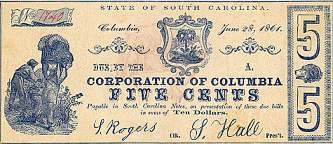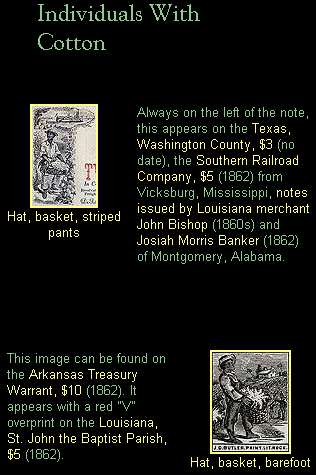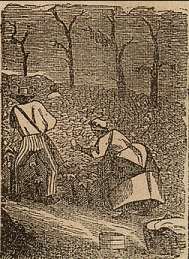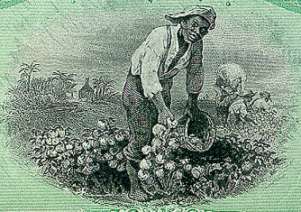
Beyond Face Value: Depictions of Slavery in Confederate Currency.
http://www.cwc.lsu.edu/cwc/BeyondFaceValue/index.htm. Leah Wood Jewett, Project Director. U.S. Civil War Center, Louisiana State University, Baton Rouge, Louisiana.
 | Image from Confederate Currency. Source:
Beyond Face Value. |
|
Culled from the private collection of Dr. Jules d'Hemecourt, who also contributes much of the text, this exhibit offers full color reproductions of seventy-six bank notes or proof plates of proposed designs for bank notes produced in slave and former states between the 1840s and the 1880s. Seeking to show that "currency is a document of culture, an artifact" that "speaks to the identity of a people, a place, and a time," this colorful, self-contained, fast-loading, and straight-forward site is arranged into seven sections. They include a description of the Economic Environment, which provides three pages of text on the issue of slavery and on the development of banking in the antebellum period; another narrative by d'Hemecourt describing The Collection, which also discusses the evolution of paper money in the American colonies and United States before the Civil War; a Bibliography of books, articles, and Web sites related primarily to the history and collectibility of historic currency; and an Overview of the Civil War.  | Image from
currency issued
by the Traders Bank
of Richmond, VA.
Source: Beyond
Face Value. |
|
Users can access the illustrations by the state in which they were issued or by the topic served by the illustrations that appear on the notes. Thumbnailed images link to windows that show remarkably detailed and well-preserved illustrations; some of the notes are quite beautiful. Sometimes both sides of the note are presented. The brief captions clearly indicate the source of the bank notes—the bank and the city or parish—and the denomination, along with an occasional reference to other notable features. A number of images appeared on several notes from different states; the captions identify the "mother"—the original note on which the illustration appeared—and lists the other denominations that used the same picture.
Collectors will enjoy and appreciate this site far more than historians. The sections of text dealing with the notes themselves are much more detailed than those describing the historical contexts in which they were issued. Although students may not be aware of antebellum currency and banking practices—which are adequately if somewhat awkwardly described in The Collection section—historians and most members of the interested public will already be aware of the fluid and even chaotic use of paper currency before and during the Civil War.
 | | Selection from Images section of Beyond Face Value. |
|
There is a reverent tone to the site; at one point the text claims that these notes "paint in broad brush and minute detail images of plantation life and slavery." They "are truly miniature works of art, recapitulating powerful events, personalities, and loyalties . . . captur[ing] in a unique, visual way the ethos of this historically significant time period." That may be true, but users will have to make those connections themselves, for there is precious little history in this site. For instance, the illustrations are arranged in The Images section by their portrayals of obviously well-fed, contented slaves at work: "Individuals With Cotton," "Individuals With Assorted Tasks," Field Scenes," "Stylistic Scenes," Post Civil War Scenes," "Sugar Plantations," and "Transportation." These categories seem a little randomly selected and sometimes awkwardly phrased; more importantly, virtually no information is provided about the true nature of slavery. Users are warned that "it is important to remember that these images were created by those who institutionalized and worked to preserve slavery" and "do not necessarily portray the slaves as they viewed themselves and their condition." That probably goes without saying, but the creators of the site miss a chance to place the collection in the context of the iconography of slavery. Indeed, even though the bibliography lists nearly six dozen books and articles and a dozen Web sites, they focus almost exclusively on currency and banking, with virtually no sources on slavery or the South. At one point Mr. d'Hemecourt claims that "Civil War history comes instantly alive through these notes," which "represent the struggle between states' rights versus the supremacy of the federal government." Yet there is only about a page-and-a-half of information on the politics of slavery and nothing about the daily lives lived by the men and women who actually endured the peculiar institution.
 | Close-up image from 1862 Mississipi
$50 bill. From Beyond Face Value. |
|
Another interesting point that goes unmade is the attitude of Southerners during the war toward paper money. The narrative quotes from the diary of the Confederate first lady, Varina Davis, in which she complains about the ravages of inflation and the worthlessness of paper money in the Confederate capital during the war, but nothing more is said about the cynicism with which even the most loyal Confederates responded to the deteriorating economy. Lucy Hull Baldwin, for instance, once imagined aloud what she would do with a hundred dollars. Her father bitterly handed her a Confederate $100 bill and said, "There! Take it down the street and see if you can buy a stick of candy." Many years later Lucy remembered this as a notable event, as the first time in her young life that she saw her parents outwardly worried. One assumes that the overwhelming majority of Southerners would not have shared the site creators' reverence toward the paper money that failed to keep food on their tables or clothes on their children.
The captions hint at the history behind these notes. One learns of the Civil War-era "100-cent" note that was regularly cut in half and circulated as fifty cent notes. White people appear on several samples, including another war-time note that shows a woman peering out to sea, waiting for her husband or father to return; the caption connects this image to conventional representations of sea-faring throughout the  | Close-up image from State of Louisiana, Shreveport and
Houston Railway Company, $1000 gold bond, 1884.
From Beyond Face Value. |
|
United States before the war. Some of these usually informative paragraphs fail to get at the whole story, however. A caption for an 1884 $1000 gold bond from Louisiana asks readers to note "the grotesque facial characteristics of the individual, in great contrast to pre-Civil War depictions" and yet nothing more is made of this possibly interesting phenomenon that may have reflected the worsening state of race relations in the United States a generation after the Civil War. Another puzzling caption appears under a $50 note from the New Orleans Bank of Improvement. The picture shows a slave planting seeds; the caption remarks that "it is unknown whether he is sowing for a plantation owner or himself using seed brought from Africa." It is hard to know what exactly this refers to; very few slaves working in the South in 1840, the date of this note, would have come from Africa, and even fewer would have managed to bring seeds through the perilous middle passage.
In the final analysis, this is by its very nature an interesting site—simply designed and attractive. But it is far more valuable in what it tells users interested in the currency of the era—especially collectors—than it is as a Civil War site, for it tells us little about the history of that war or its legacies.
James Marten
Marquette University
~ End ~
Web Site Review of Face Value: Depictions of Slavery
in Confederate Currency
Copyright
© 2000, 2001 by The Journal for MultiMedia History
Comments
| JMMH Contents |




